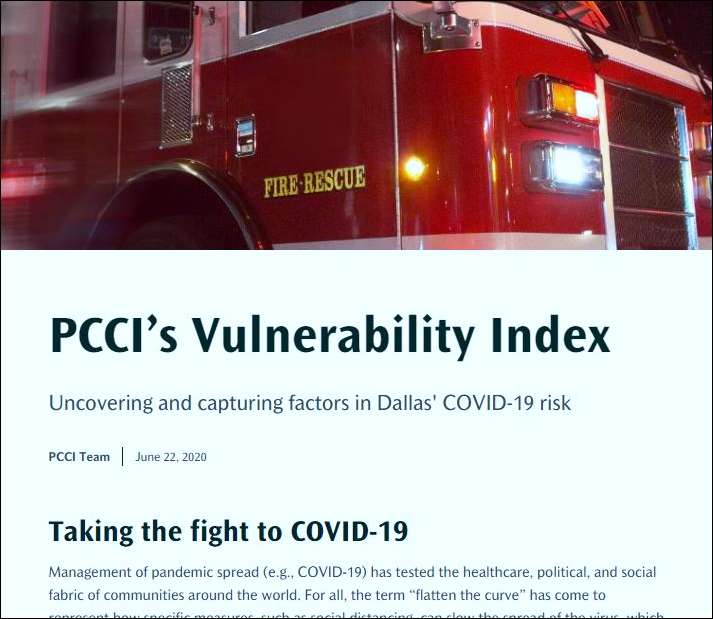
DALLAS – Parkland Center of Clinical Innovations’ (PCCI) Vulnerability Index has noted a small, but important decline in COVID-19 risk for much of Dallas County between July and August.
 Launched in June, PCCI’s Vulnerability Index determines communities at risk by examining comorbidity rates, including chronic illnesses such as hypertension, cancer, diabetes and heart disease; areas with high density of populations over the age of 65; and increased social deprivation such as lack of access to food, medicine, employment and transportation.
Launched in June, PCCI’s Vulnerability Index determines communities at risk by examining comorbidity rates, including chronic illnesses such as hypertension, cancer, diabetes and heart disease; areas with high density of populations over the age of 65; and increased social deprivation such as lack of access to food, medicine, employment and transportation.
Based on tracking its key factors, including changes in confirmed
The most at-risk ZIP code continues to be 75211, around Cockrell Hill. This area was the most as risk area for both July and August.
COVID-19 cases and in mobility, the PCCI Vulnerability Index saw a modest decrease in the COVID-19 risk due to decreased COVID-19 cases across. However, several zip codes showed relative increases in their risk due to increased mobility compared to the same period in 2019 and a higher relative proportion of COVID-19 cases in their area compared to July.

The ZIP code with the biggest jump in vulnerability to COVID-19 infection by the end of August was 75217, the region that includes Pleasant Grove, intersected by Loop 12 and U.S. Highway 175. This ZIP code jumped from 5.3 percent vulnerability rating to 93.5, making it one of the most vulnerable ZIP codes in Dallas County.
The ZIP code 75230, north of Walnut Hill Lane between U.S. Highway 75 and Dallas North Tollway, and 75218 immediately east of White Rock Lake, saw the largest drops in their vulnerability risk going from 45.6 to 12 and 38.9 to 16, respectively.
“The data offered by our vulnerability index is showing that Dallas County is taking incremental, but i
mportant steps in managing COVID-19 risks,” Thomas Roderick, PhD, Senior Data and Applied Scientist at PCCI. “The changes we are witnessing are generally based on two important dynamic elements: recent confirmed COVID-19 cases, and mobility t hat includes people moving and gathering. For much of the county the number of confirmed COVID-19 cases began to slow in August, compared to July. With no holidays in August, there were fewer large gatherings and travel. These two factors can account for overall decrease across the county. Those areas experiencing increases in vulnerability ratings are largely attributed to yearly increases in mobility and to ongoing COVID-19 hotspots in a particular ZIP code.”
hat includes people moving and gathering. For much of the county the number of confirmed COVID-19 cases began to slow in August, compared to July. With no holidays in August, there were fewer large gatherings and travel. These two factors can account for overall decrease across the county. Those areas experiencing increases in vulnerability ratings are largely attributed to yearly increases in mobility and to ongoing COVID-19 hotspots in a particular ZIP code.”
While August’s vulnerability index for Dallas County provides positive signs, Dr. Roderick warns that the Labor Day holiday, school openings, and sporting events may contribute to increases in vulnerability and COVID-19 cases. Additionally, he stresses the importance of personal behavior, such as wearing a mask, social distancing, and following the CDC guidelines.

The PCCI COVID-19 Vulnerability Index can be found on its COVID-19 Hub for Dallas County at: https://covid-analytics-pccinnovation.hub.arcgis.com/.
Data Sources:
To build Vulnerability Index, PCCI relied on data from Parkland Health & Hospital System, Dallas County Health and Human Services Department, the Dallas-Fort Worth Hospital Council, U.S. Census, and SafeGraph.
About Parkland Center for Clinical Innovation

Parkland Center for Clinical Innovation (PCCI) is an independent, not-for-profit, healthcare intelligence organization affiliated with Parkland Health & Hospital System. PCCI leverages clinical expertise, data science and Non Medical Drivers of Health to address the needs of vulnerable populations. We believe that data, done right, has the power to galvanize communities, inform leaders, and empower people.
###






